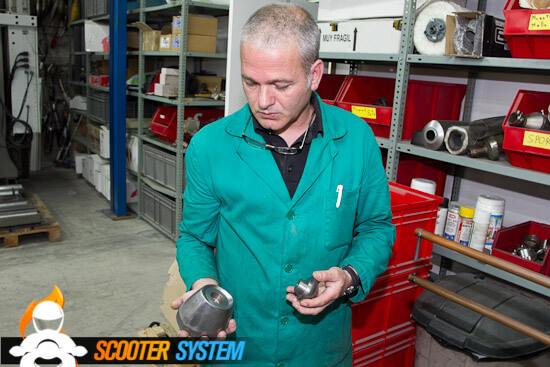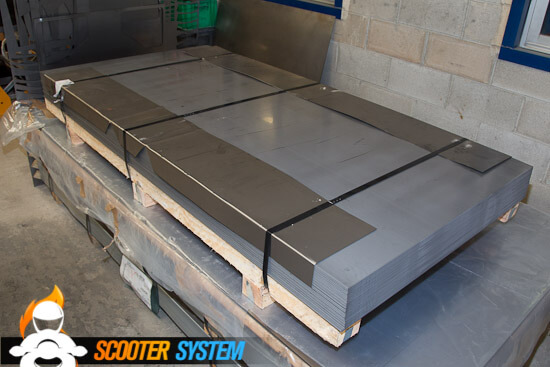This site uses cookies to provide you with a great user experience and to show you relevant ads. If you’re OK with that, just continue. To find out more, please review our privacy policy.
Yasuni exhausts are designed, tested and manufactured entired in-house in the Yasuni factory in Barcelona, Spain.
Last week we went to visit the company and factory to see what goes on and get an insight into the Yasuni manufacturing process.
This blog is a brief introduction to the Yasuni factory and follows all stages of how a Yasuni scooter exhaust is made from initial design and development through to the final boxed product.

The birth of a new exhaust Yasuni begins, as so often today, with extensive computer design and simulation work.
Each Yasuni exhaust design must be carefully calculated to accomodate both the design and shape of the exhaust (which is critical to match the intended power curve) and the physical size and shape constraints of the scooter or bike to which it's being fitted.
The picture below shows the CAD 3D model design for a new exhaust Yasuni 4 exhaust being designed for a four stroke maxi scooter.

Once the 3D model is completed the next step is to make the tooling and jigging which allows prototypes and eventually the final version of the exhaust to be made over and over again with the exact same specifications each time. The tooling is again designed and drawn on 3D computer modelling software and then fabricated in-house in the Yasuni factory.
In the picture below the tools shown are those needed to create a Yasuni 4-stroke scooter exhaust as in the previous example.

To form each separate part of the body such as cone sections or elbows, machines are used which very precisely mould, compress and bend steel sheet to each of the desired shapes individually. The photos below show a mould cup and then the separate manufactured component parts which make up a Yasuni 4 scooter exhaust.


When all the metal parts are machined, they are assembled to form the first prototype
Everything is made in-house from the exhaust cone sections, elbows and silencers through to the brackets and clamps.
The first prototype is then fitted to a scooter where it begins a laborious process of extensive dyno performance testing before being tweaked, remade and retested as necessary until the design is final.

The majority of Yasuni development is to carried out on the test bench.
For this Yasuni has a fully equipped dedicated dyno testing room purpose built specifically to test 50cc mopeds, 125cc, maxi scooters and motorcycles.
The design of the silencer does not take place until the actual pipe design is finalised and the exhaust power curves and torque are fully optimised.

Before the new Yasuni exhaust can go into commercial production and is added to the Yasuni catalogue, a final series of tests must be made in real conditions.
In order to do this scooters are sent out on the local roads of Catalonia for several thousand miles of driving.
Shown below are the Honda SH and Yamaha X-Max which were used for road testing of two of the Yasuni 4-stroke maxi-scooter exhausts.

As well as the commercial production and development of new motorcycle and scooter exhausts, the engineers at Yasuni are often commissioned to make highly specialised tailor-made custom exhausts for one-off race applications.
Unlike mass-market exhausts, these are often made from titanium for the ultimate in light-weight strength and quality. Fabrication with titanium requires very specialist equipment and skills.
The picture below shows an isolation tent (used to replace oxygen with an inert gas) which is necessary for welding titanium.

For these very specialised one-off productions, each exhaust is designed and tailor-made according to the specifications and requirements of the customer. This results in a unique exhaust with ultimate performance characteristics specifically tailored to the specifications to that customer, and giving him a unique edge in his field/
The below shows the body of one of these exhausts partially contructed.
The assembly and welding quality is of course an impeccable work of art and at testiment to the Yasuni reputation for quality.

But back to the manufacture of the scooter Yasuni exhausts we all know and love!
The picture below shows pallets of high quality 304 stainless steel used in the exhaust manufacturing process.
Because steel prices and availability varies on a day to day basis Yasuni stores raw materials such as this in large quantities in order to meet demand reactively and control purchasing costs and ultimately of course this helps keep final customer prices low.


As mentioned previously even all Yasuni small parts are fabricated in-house.
The next picture shows a CNC laser cutting machine as it cuts out a sheet of exhaust brackets.
CNC technology offers the ultimate in both accuracy and cutting speed, with it being able to cut very accurately to within very small tolerances.

A little further on another cutting machine, (mechanical this time!), precisely cuts long lengths of steel tubing into precise lengths ready for bending. This huge cutting machine can operates very quickly and cuts through steel like butter, but always with an accurancy down to just tenths of a millimeter ...

Although the CNC machines are programmed to cut out parts in the most efficient way possible there is always inevitably going to be some waste.
These are kept by Yasuni and sent to be recycled. They are ultimately returned as new steel sheets ready to be cut again!

Once the flat pieces of metal which go to make up a Yasuni exhaust have all been cut, they need to be shaped to form the cone sections which will ultimately be welding together to form the complete exhaust. Each cone section of each exhaust then has to be shaped around a moulding tool to ensure it is the perfect designed shape.
The picture below shows some of these tools as made in the development process.

Once all the parts are assembled and shaped, the next step is where the exhaust really starts to come together... the welding! Yasuni specifically employs a handful of highly skilled welders who's job it is solely to operated the welding equipment and perform the high quality incricate TIG welding for which Yasuni is so well known.
The skill of the welders is of course crucial for the final quality of the exhaust.


After being left to cool the following picture shows the exhaust as they leave the welding section and ready for the next stage of assembly.

Finally the exhausts are ready to be packed, this is a fulltime job for one employee!
In a room dedicated to this stage, this employee is responsible for assembling the parts and accessories that come with the exhaust itself... mounting bracket, springs, nuts, gaskets etc.
In case of any doubt there is always a physical parts 'checklist' available for each individual exhaust.




Finally the completed exhausts are packed into cardboard boxes and sent to the storage section where Yasuni houses nearly 100 different exhaust lines before being dispatched to its customers across Europe and the world.
Each year, Yasuni produces tens of thousands of exhausts, and thanks to its high manufacturing standards and quality policy has an exceptionally low rate of return!

I hope you enjoyed our visit to the Yasuni factory and discovering how their exhausts are made!
A big thank you to the Yasuni team for their hospitality.
This article has been reproduced and translated by Pedparts with the kind permission of the original author http://www.scooter-system.fr and Yasuni Exhausts
